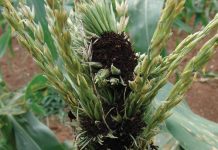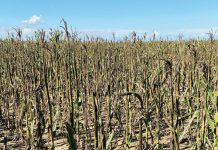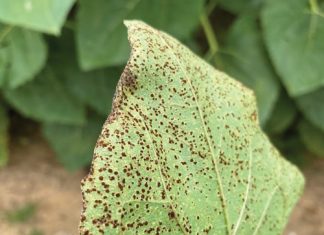
Charcoal rot, caused by the fungus Macrophomina phaseolina, is a soil- and seed-borne pathogen that can affect at least 500 plant species, including economically important crops such as maize, sunflower, soybean, and cotton. It thrives in warm, dry conditions and is particularly problematic in regions experiencing drought or high temperatures.
With climate change leading to more frequent droughts and higher temperatures in South Africa, favourable conditions for the fungus to flourish became more prevalent. Yield loss in South African maize due to charcoal rot can be significant based on reports that indicated yield losses ranging from 40 to 70% in affected fields. These losses are particularly severe during drought conditions, which favour the growth and spread of the fungus.
The fungus produces microsclerotia, which are resilient structures that can survive in the soil for many years, even under adverse conditions. The use of chemicals to control charcoal rot is limited because the fungus occurs in the soil and is difficult to reach. The most effective and environmentally friendly management option remains the use of cultivars resistant to charcoal rot. Previous research conducted at the ARC-Grain Crops in Potchefstroom has developed a screening method to identify resistant maize cultivars.
These screenings indicated that certain cultivars had lower disease ratings in field trials over a period of three years, which showed promising results in terms of disease management. Researchers at the ARC-Grain Crops have been tasked with conducting additional studies on charcoal rot of maize and to map its distribution range. This article aims to provide information about charcoal rot and to encourage producers to report any occurrences of the disease.
Symptoms of charcoal rot
Initial symptoms in maize can be observed after flowering, manifesting as abnormal drying of leaf tissues (Photo 1), stalk lodging, and premature death. When plants
approach maturity, the lower stalk nodes (usually limited to the first five nodes) show a typical charcoal, grey-black discolouration (Photo 2). When an infested stalk is opened, numerous black specks (microsclerotia) are visible in the shredded vascular bundles and on the inside of the stalk (Photo 3).
The numerous sclerotia (survival structure) of the fungus are small, black, and spherical and occur on and inside the vascular strands to cause the internal stalk tissue to appear ‘charred’. Translocation of water and nutrients is disrupted due to hyphae of the fungi that grow intercellularly through the xylem and into the surrounding vascular tissue. Weakened stalks cause the plants to fall over during strong winds and yield losses occur.

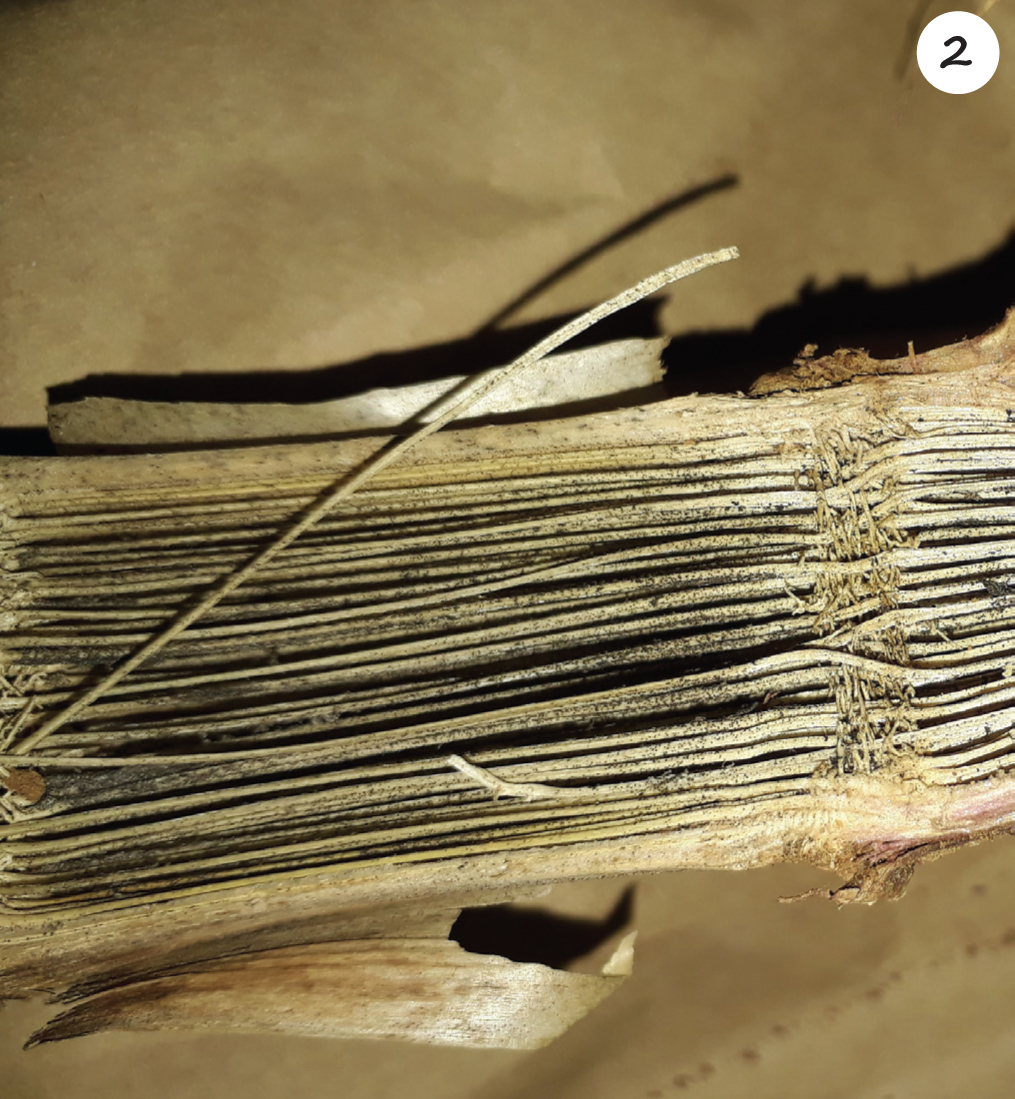
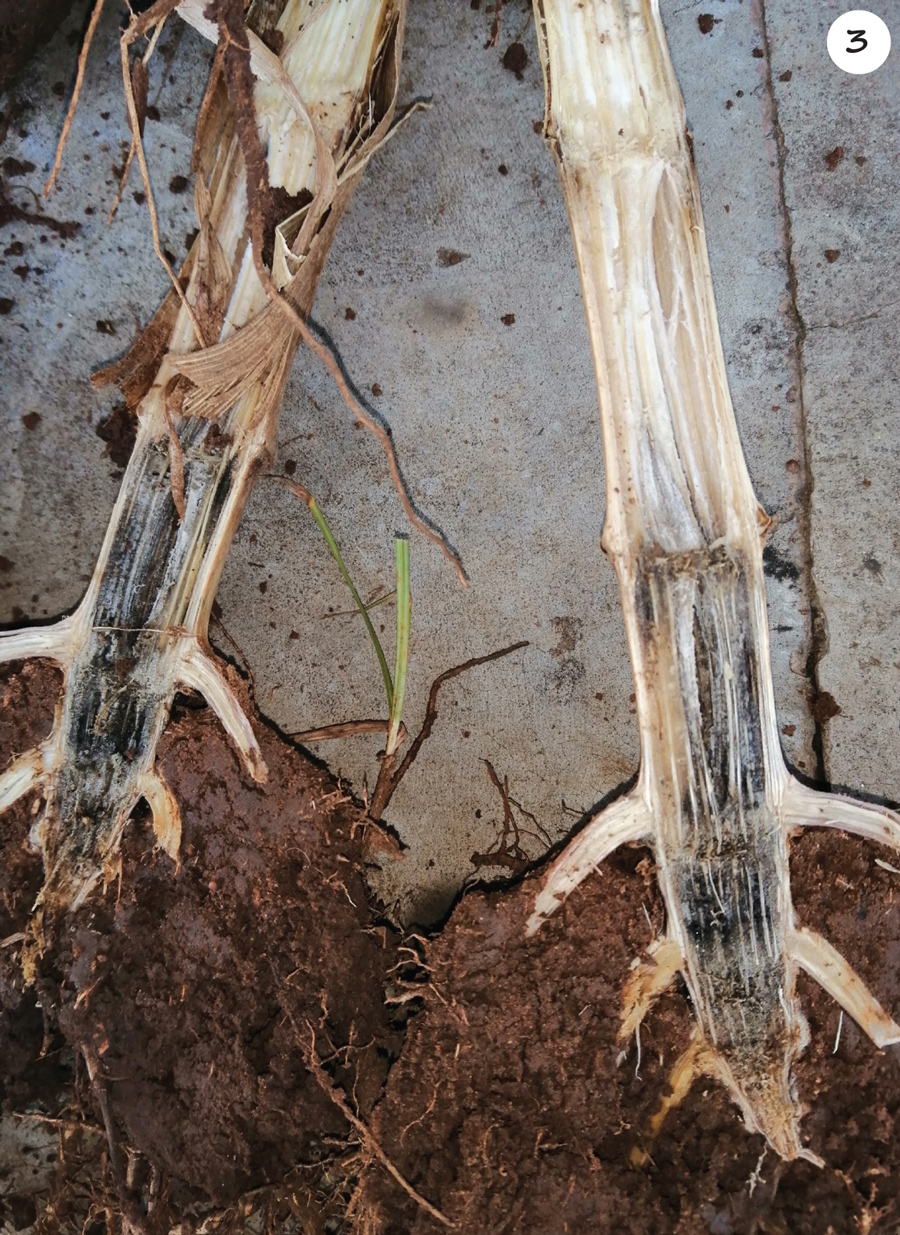
Conditions favouring charcoal rot
Temperatures from 30 ºC upwards and low moisture levels in the soil favour disease proliferation. Drought conditions that occur during flowering render maize plants highly susceptible to charcoal rot infection. Sclerotia can persist in the soil, seeds, and plant residues; therefore the continuous planting of monoculture maize can lead to an increase in charcoal rot infections.
Management options
Depending on rainfall, early planting and maintaining low plant populations can reduce competition for water and nutrients. Effective irrigation practices, especially as the crop nears flowering stage, can alleviate drought stress and lower the risk of charcoal rot infection since the fungus does not thrive in moist soils. Minimising insect damage and crop wounding reduces potential infection points. Rotating to non-host crops such as small grains or cereal grains can decrease disease potential.
It is important to note that many crops, including soybean, grain sorghum, and sunflower as well as various weeds act as alternative hosts to this disease. Rotating away from a host crop for three years can significantly reduce fungal spore numbers, especially where severe infestations occur. For more information on cultivars resistant to charcoal rot, producers can refer to previous articles that were based on research by ARC-Grain Crops and published in SA Graan/Grain magazine. Additionally, cultivars resistant to Diplodia and Gibberella stalk rot can also provide genetic resistance to charcoal stalk rot.
Producer participation to monitor charcoal rot occurrence
Researchers at ARC-Grain Crops are currently conducting a study on charcoal rot in maize that is funded by the Maize Trust. One of the project’s objectives is to monitor the prevalence of the disease in South African maize fields. Previously, large-scale monitoring of charcoal rot occurrence in South Africa was scanty. This initiative will offer several benefits to producers and researchers, such as the following:
- Regular monitoring allows for the early identification of charcoal rot, which will enable timely interventions to prevent the spread of the disease.
- By pinpointing affected areas, producers can implement specific disease management practices such as crop rotation and the use of resistant cultivars to mitigate the impact of the disease.
- Monitoring promotes the protection of crop yields by minimising charcoal rot damage, which can be particularly severe under drought conditions. Effective monitoring allows for better resource allocation such as the application of irrigation and pest control measures to areas most at risk, thereby optimising input use and reducing costs.
- Data and isolates collected from monitoring can act as a source of information for research efforts aimed at breeding more resistant maize varieties and improve disease management strategies.
- Reducing the incidence and severity of charcoal rot leads to better economic returns for producers through higher yields and reduced losses.
 Overall, monitoring charcoal rot is a proactive approach that helps maintain the health and productivity of maize fields in South Africa.
Overall, monitoring charcoal rot is a proactive approach that helps maintain the health and productivity of maize fields in South Africa.
Producers and agents noticing charcoal rot symptoms in maize plantings are requested to reach out to Dr Belinda Janse van Rensburg at 018 299 6357 or via email at BelindaJ@arc.agric.za.





